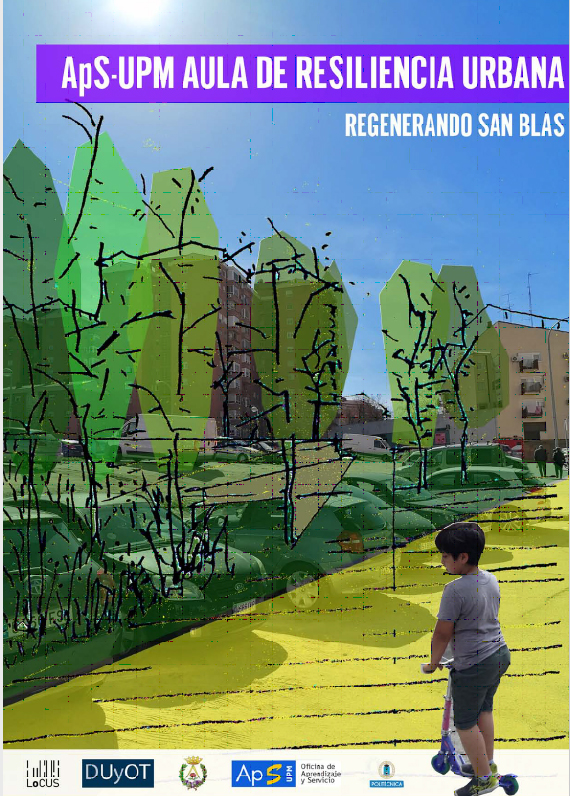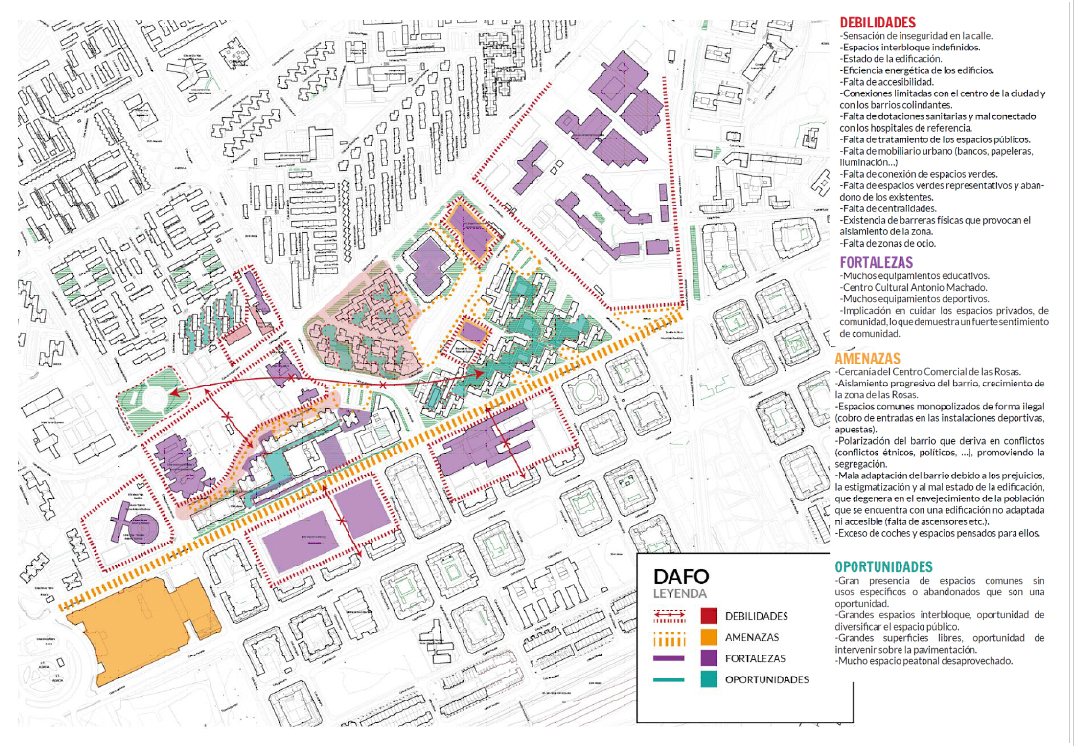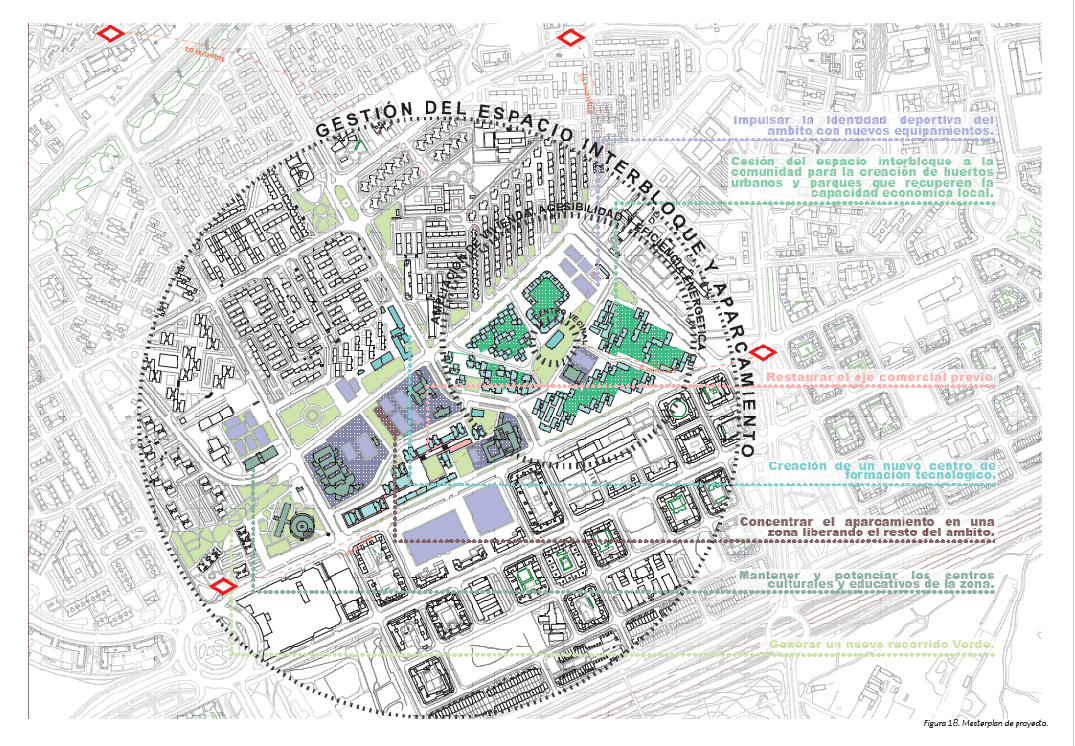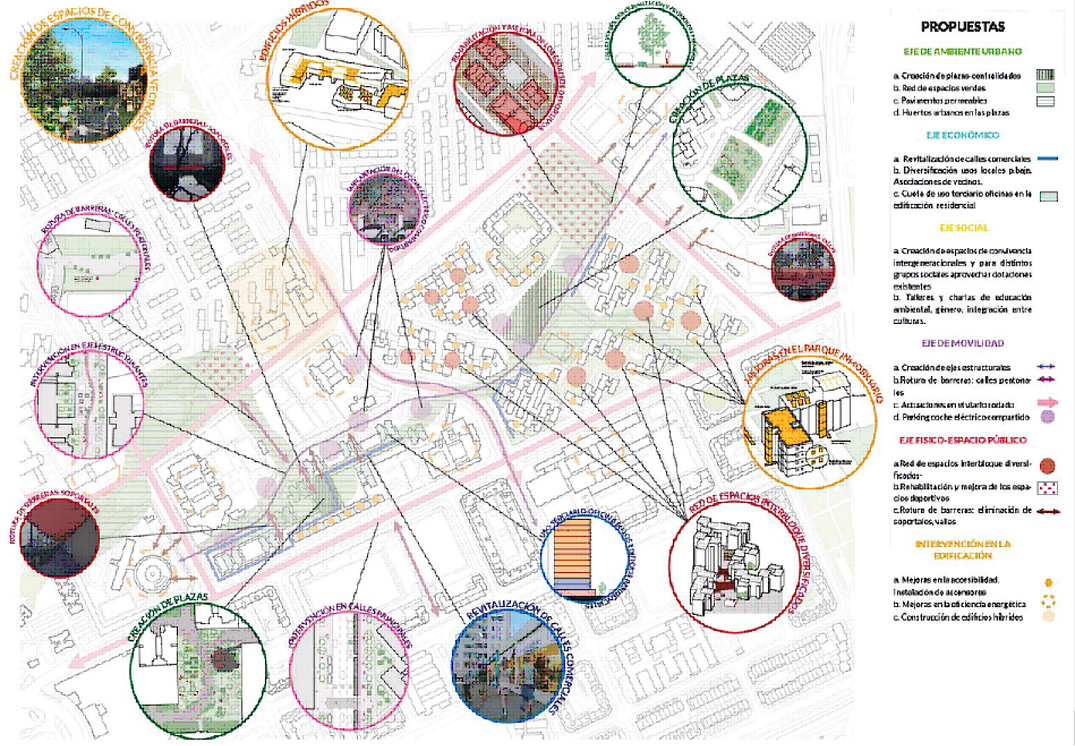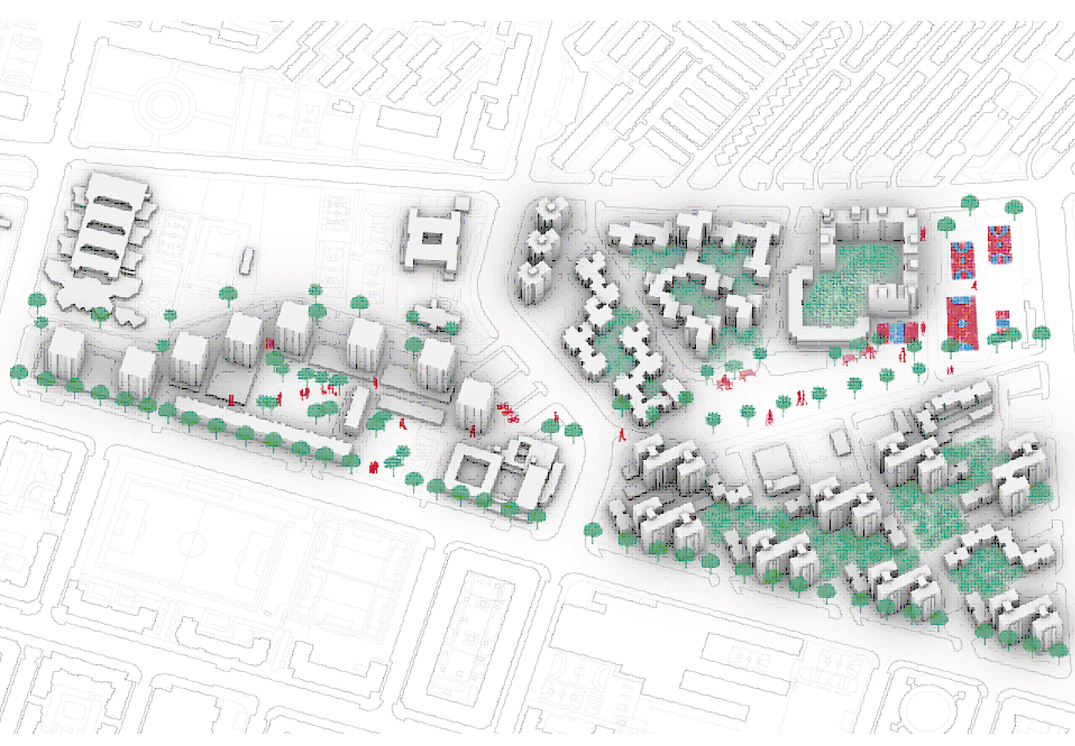URBAN RESILIENCE CLASSROOM
Basic information
Project Title
Full project title
Category
Project Description
The Urban Resilience Classroom is a didactical program on urban regeneration in which students are actors for change in the city of Madrid. The students of the Grade of Architecture in ETSAM learn and work to provide evidence to the Madrid Municipality on the need and the benefits of addressing the situation of the vulnerable neighborhoods through holistic urban regeneration strategies. They do this interacting with the social tissue of the area and in a transdisciplinary learning framework.
Geographical Scope
Project Region
Urban or rural issues
Physical or other transformations
EU Programme or fund
Which funds
Description of the project
Summary
At a time when urban vulnerability in our city (Madrid) has increased due to the COVID-19 pandemic and extraordinary economic resources (Recovery, Transformation and Resilience Plan of the city of Madrid ) have been put in place to deal with the associated crisis (counting with the support of the EU Next Generation funding), we believe that the urban regeneration of vulnerable neighborhoods must play an essential role in the way out of this crisis.
We firmly belive that the University has the responsability to point out policy gaps to decisor-makers and institutions. Because of this we put into place the Urban Resilience Classroom, a learning framework in which the students of the Grade of Architecture in UPM have worked in the area of San Blas (Madrid) developing solid and realistic integrated urban regeneration strategies for this vulnerable urban area. The objective has been to put on the table of the Madrid City Council a set of urban regeneration strategies that demonstrate that the urban regeneration of the vulnerable neighborhoods of our city is not only a necessity, it is also an opportunity to advance towards a more resilient and just Madrid.
For this, along the semester of Spring 2021 in ETSAM-UPM, a group of students were inmersed in a multidisciplinar learning framework on integrated urban regeneration, counting with professors of different backgrounds and countries with the aim of providing them the most innovative and complete knowledge on the matter (see complementary information -ebook-).
The strategies for the urban regeneation of San Blas developed by the students have been very well valued by the neighbourhood association (that collaborated in the project). Beyond this, the Urban Resilience Classroom has resulted in the commitment and understanding of the students about the relevance of regenerating the vulnerable urban areas. Because of this, they have become actors of change towards more sustainable and resilience cities in the EU
Key objectives for sustainability
The most relevant objectives of the project in terms of sustainability were the following:
- Providing students with a solid knowledge on "urban sustainability" and understanding on how this concept is at the base of the "urban regeneration" concept that has been proposed from the 1980s by the European Union to address the problems of the vulnerable neighbourhoods of European cities.
- Providing students with a learning-service process in which students can develop skills to develop integrated urban regeneration strategies able to act in the social, physical/environmental, economic and governance dimensions of depravation in vulnerable neighbourhoods.
- Making students of the Grade in Architecture aware of their "future responsability" as professionals from which the society expect reliable and efficient solutions to complex urban problems, and provide them with objective information about the relevance of addressing the problems of the most vulnerable areas of our cities. These areas are those that have been hit the most by the COVID-19 pandemic, which has worsened the quality of life of their inhabitants keeping them trapped in the poverty cycle.
These objectives have been met by applying a multidisciplinary learning process, and by creating a framework of collaboration of the neighbourhood association with the students within the Urban Resilience Classroom.
This has resulted in a different way of teaching urban regeneration in which students have worked as near as possible to the "real conditions" in which they will develop their future professional career. The service-learning approach adopted motivated the students importantly. They got very engaged with the vision proposed and the possibility to be able of exerting an influence in the policy agenda of the Municipality in favour of the urban regeneration of vulnerable areas.
Key objectives for aesthetics and quality
The most relevant objectives of the project in terms of aesthetics and quality of experience beyond funtionality were the following:
- Making students familiar with the knowledge provided by neuroscience, a field of research that in the last decades has demonstrated the relevant role that "beautifulness" plays in stimulating the human brain. It has demonstrated that the human brain has an innate need for "beauty". Taking this into the urban regeneration of vulnerable neighbourhoods provides an axis of action with a high potential of transformation.
- Constructing in a collaborative way (in the framework of the Urban Resilience Classroom) our own definition of "beauty", with the aim of overcoming "only-aesthetics" definitions and with the intention of making students aware of: i) the relevance of the aesthetic experience in the development of sustainable communities in vulneable areas; ii) the relations about aesthetics and environmental and social issues; iii) the need to integrate aesthetics in the discourse on sustainability.
- Providing students with the capacity of applying all this in the development of integrated urban regeneration strategies for the neigbourhood of San Blas. The aim was to provide them with a concept of "beauty" (understood as mentioned in the previous point) that could act as a crucial driver for a positive transformation of San Blas.
These objectives were achieved through the developed of dialogic sessions in which students reflected on the capacity of "the beauty" to transform urban areas in the context of urban regeneration strategies. We also developed a learning process based on the film "La Grande Bellezza" of Paolo Sorrentino. The film gave the group the possibility to deconstruct and construct again (with an eye on urban regeneration) the concept of beautifulness, avoiding stereotypes and biases.
This part of the course was very well valued by students and resulted in valuable results.
Key objectives for inclusion
The most relevant objectives in terms of in terms of inclusion were the following:
EQUAL OPPORTUNITIES:
- Providing students with evidence on the relevance and need of applying the gender perspective in urban regeneration. Making them familiar with the fact that gender is a factor that reinforces the situation of vulnerability wherever it exists (e.g.: women are more vulnerable than men to climate change dissasters, women are more vulnerable to financial crises because normally they have lower salaries and more precarious jobs, etc.). Thus, it makes a lot of sense to act in vulnerable urban areas of our cities from an equal opportunities approach.
- Providing students with knowledge on how urban regeneration strategies can benefit of the equal opportunities perspective. (For this we used as a manual the guide developed by the Government of the Vasque Country on Urban Regeneration with a gender perspective in the framework of the Urban Agenda of the Vasque Country that can be downloaded from this link: https://www.euskadi.eus/contenidos/informacion/regeneracion_urbana/es_def/adjuntos/Regeneracion-Urbana-Perspectiva-de-Genero.pdf ).
PARTICIPATION AND CO-CREATION:
- Counting in the framework of the Resilience Classroom with the collaboration of the neigbourhood association (Plataforma Vecinal San Blas-Simancas) in order to give place to an integrated diagnosis of San Blas in which its "non-expert knowledge" could be fully integrated. We aimed to achieve an accurate knowledge of the requirements, needs and expectations of the local community with regard its neigbourhood.
- Liasing as much as possible with the neigbourhood association in the framework of the course.
ACCESSIBILITY:
- Making students aware of the relevance of giving place to a transformation of the public space, the facilities, and the buildings of apartments in which all people could access regardless their age, health condition, race (taking into account also "subjective accessibility" to places)
Results in relation to category
The project applies for the category: "Prioritising the places and people that need it the most".
The urban areas that need more attention from decisor-makers and institutions in the framework of the EU are the so-called vulnerable neighbourhoods. They are areas segrated physically and socially were vulnerability concentrates. The Urban Resilience Classroom focuses on them in the city of Madrid with the aim of providing the Municipality with sound and realistic strategies of urban regeneration, developed by the students, that demonstrate to this institution that the regeneration of the vulnerable areas of our city is an urgent need and an opportunity in the present moment.
With this action the Urban Resilience Classroom aims to "motivate" the Municipality to adopt this vision, so that it is integrated in the Recovery, Resilience and Transformation Plan of Madrid. This plan will be using the Next Generation funding coming from the EU to face the dramatic socio-economic crisis due to the COVID-19 pandemic. This pandemic has worsened the situation of the vulnerable neighbourhoods of the city of Madrid. Our point is that a part of this budget should go to these areas. This vision is highly rooted in our understanding of the University as a place that has the responsability to point out gaps in public policies and to propose approaches that could importantly benefit to our society.
How Citizens benefit
The main actors external to the University (Universidad Politécnica de Madrid) that were involved in the project were the following:
-Neighbourhood assoacition of San Blas (Plataforma Vecinal San Blas-Simancas).
-Municipality of Madrid.
Both of them were invited to join the Urban Resilience Classroom at the beginning. They collaborated explaining to the students what was the situacion of San Blas (each of them from their point of view) and what were the needs of this urban areas and its main problems. This provided students with a rich and deep understanding of the area, giving them the possibility to compare the different approaches to this very important actors to the area as well as their different objectives for it. This provided students with an insight into the "real word" in which in few years they will be developing their professional activity as urban planners and architects.
Students valued a lot being able to have a direct access to these crucial actors.
Again, it is relevant to mention that the pandemic reduced the number of actors that could participate in the project becaus of mobility and meeting restrictions. The interaction among students, the neigbourhood association and the Municipality took place through telematic means during the Spring of 2021.
Physical or other transformations
Innovative character
The Urban Resilience Classroom has provided students with a learning framework in which they have achieved knowledge and experience on urban regeneration by applying a different learning method. We have put into place a service-learning process that present a number of differences with mainstream teaching on urban regeneration:
-Students had the change to listen and to dialog with two main actors in the processes of urban regeneration: the local community (represented by the neigbourhood association) and the Municipality. This provided students with a learning process developed in a framework as similar as possible to the "real world".
-Students were provided with knowledge on different aspects of urban regeneration provided by a relevant team of teachers and experts with very different backgrounds. The profile of the professor that were invited to join the UrbanResillience Classroom was selected accuratelly, so that students could be provided innovative knowledge on relevant urban regeneration issues (public participation, mobility, energy efficiency, gender equality, climate action -mitigation and adaptation-, urban economics, and public policies). The aim was provide students with a multidisciplinar understanding of urban regeneration aimed to prepare them to work in the future in multidisciplinar professional teams.
-Students were super motivated knowing that their strategies had the objective of demonstrating to the Municipality that the urban regeneration of the vulnerable neigbourhoods of Madrid is not only an urgent need, but also an opportunity to achieve the ecologic and fair transition that the EU needs to make to achieve the objectives of the EU Green Deal by 2050. Their engagement with this idea was very strong. Because of this, they were actors of change during the development of the Resilience Classroom. The knowledge and commitment they have achieve guarantees that they will act also as actors of change along their future professional career.
Learning transferred to other parties
The Urban Resilience Classroom approach, learning method, and objectives can be easily transferred to other University courses on urban regeneration in Europe. This is because it faces an EU-wide challenge (vulnerable neighbourhood) that is present in all EU cities and that is gaining relevance in the present scene.
The transfer to other interested parties and contexts could even reinforce the motivation of the students, as they would be learning in parallel with other students from other countries and universities to achieve a similar objective.
The transfer could have place through short stages of professor from other Universities in Universidad de Madrid. We could inform them about the implementation of the service-learning approach, the method we have used to engage the students with the ambitious objective of the Urban Resilience Classroom. We could also share with them the material that have resulted from the development of the project.
The principle of this initiative is to give place to a multidisciplinary learning process in which students are provided with the tools and knowledge that would allow them developing realistic and sound urban regeneration strategies for the vulnerable neighbourhoods of a specific city. For this, the course should count with the collaboration of key actors (at least the neighbourhoods association and the Municipality) so that students get familiar with the urban complexity and conditions they will face in their future professional work. The outcome of the course are: i) a set of strategies for urban regeneration that are proposed to the Municipality to an example on how to act to face the problems of vulnerable neighbourhoods; iii) students that become actors of change towards more sustainable and resilience European cities.

